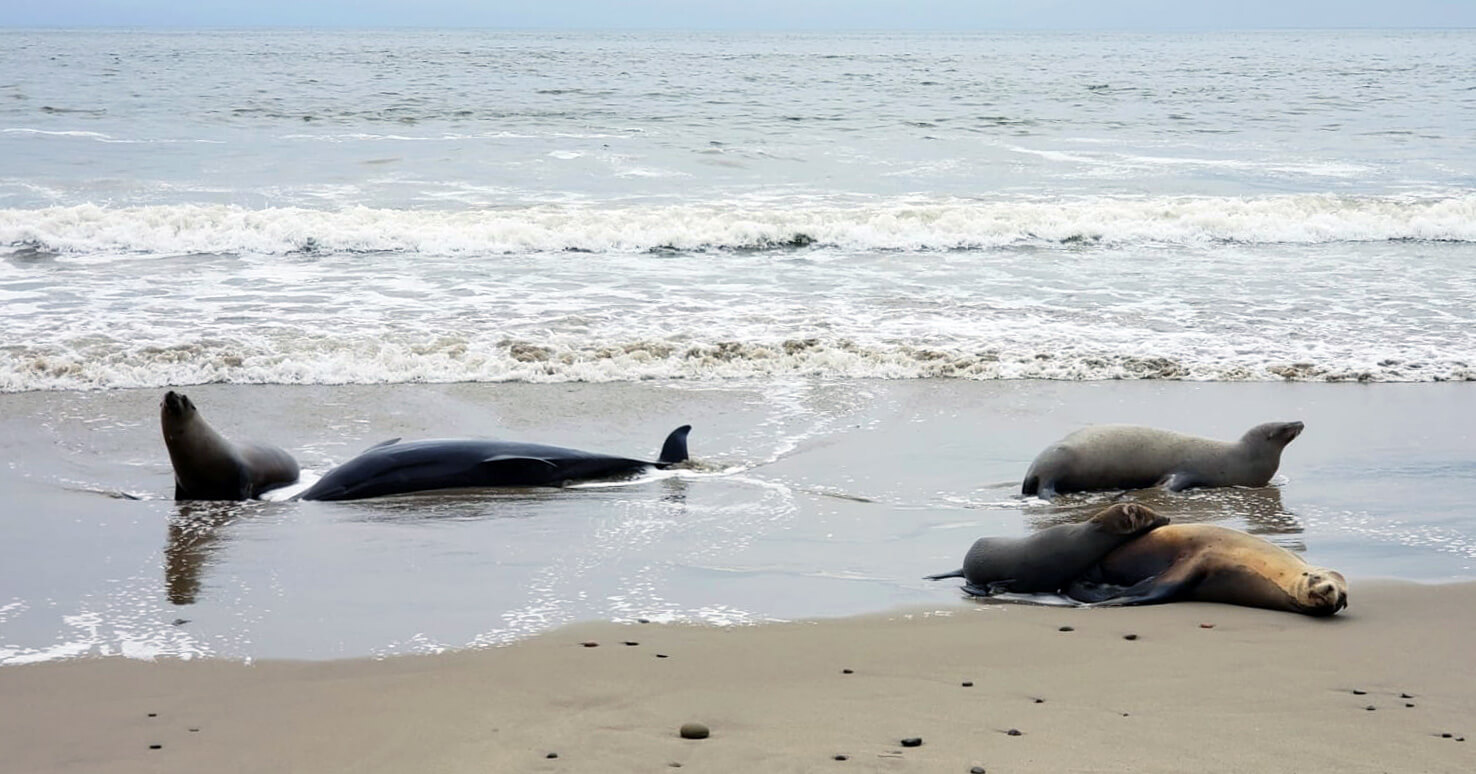Harmful Algal Bloom Crisis: Threat To California's Marine Life

Table of Contents
California's stunning coastline, renowned for its biodiversity, is facing a growing threat: harmful algal blooms (HABs). These explosive growths of microscopic algae produce toxins that contaminate the water, leading to devastating consequences for marine life and potentially human health. This article explores the crisis, its causes, effects, and what can be done to mitigate this escalating environmental problem. The increasing frequency and intensity of these blooms are a serious concern for both the environment and the economy of California.
Understanding Harmful Algal Blooms (HABs) in California
Harmful algal blooms (HABs) are rapid increases in the population of algae in water, often resulting in discoloration of the water (red tide is a common example). These blooms aren't all harmful, but some produce toxins that can have devastating effects on marine life and even humans. In California, several species of algae are responsible for these harmful blooms, including Pseudo-nitzschia (which produces domoic acid) and various species of dinoflagellates.
-
Nutrient Runoff: Excess nutrients, primarily nitrogen and phosphorus from fertilizers used in agriculture and sewage discharge, act as potent fertilizers for algae, fueling their explosive growth. Agricultural runoff from the Central Valley significantly contributes to coastal HABs.
-
Climate Change: Warmer ocean temperatures, caused by climate change, create ideal conditions for many HAB species to thrive and proliferate. Altered ocean currents can also contribute to the transport and spread of these blooms along the California coast.
-
Oceanographic Conditions: Upwelling events, which bring nutrient-rich deep water to the surface, can provide the necessary nutrients to trigger large-scale HABs. Specific currents and water temperature stratification also play a crucial role in bloom formation and their movement along the coastline.
Devastating Impacts on California's Marine Ecosystem
The toxins produced by HABs, like domoic acid, cause widespread harm to marine life. Fish kills are a common occurrence, with entire populations of commercially important species decimated. Shellfish, which filter feed and accumulate toxins, become unsafe for human consumption.
-
Economic Consequences: The closure of shellfish beds due to HABs leads to significant economic losses for the fishing industry and related businesses. The decline in fish populations also impacts recreational fishing and tourism.
-
Disruption of the Food Web: HABs cause cascading effects throughout the marine food web. The death of phytoplankton and zooplankton, the base of the food chain, impacts the survival of larger organisms that rely on them for food.
-
Impacts on Wildlife: Marine mammals, seabirds, and other wildlife can suffer from HAB toxins through bioaccumulation. They ingest contaminated prey, accumulating higher concentrations of toxins in their tissues, leading to illness and death. This bioaccumulation poses a significant threat to many endangered species along California's coast.
Human Health Risks Associated with California's HABs
Consuming shellfish contaminated with HAB toxins poses significant risks to human health. Several types of shellfish poisoning exist, including paralytic shellfish poisoning (PSP), diarrhetic shellfish poisoning (DSP), and amnesic shellfish poisoning (ASP), caused by different algal toxins.
-
Health Symptoms: Symptoms of shellfish poisoning vary depending on the toxin ingested but can range from nausea and diarrhea to neurological symptoms such as paralysis, memory loss, and even death.
-
Monitoring and Advisories: California's public health agencies regularly monitor shellfish beds for toxins and issue advisories when unsafe levels are detected. It is crucial to heed these advisories and avoid consuming shellfish from affected areas.
-
Recreational Risks: Direct contact with HABs can also cause skin irritation and respiratory problems, particularly in individuals with pre-existing conditions. Beach closures are sometimes necessary to protect public health.
Monitoring and Mitigation Strategies for California's HAB Crisis
California employs various monitoring programs to track HABs, including satellite imagery to detect changes in ocean color and regular water sampling to identify and quantify algal toxins.
-
Mitigation Strategies: Reducing nutrient pollution through improved wastewater treatment, sustainable agricultural practices, and stricter regulations on fertilizer use is crucial in mitigating HABs.
-
Research and Technology: Advancements in scientific research and technology are vital for improving HAB prediction models and developing novel control strategies. This includes exploring the use of innovative technologies to manage and control HABs.
-
Public Awareness: Educating the public about the risks of HABs and the importance of following public health advisories is crucial for protecting human health and the environment. Public awareness campaigns can significantly improve community response to HAB events.
Conclusion
The harmful algal bloom crisis in California poses a significant threat to the state's marine ecosystem and human health. The combined effects of nutrient pollution, climate change, and oceanographic conditions are fueling the increasing frequency and intensity of these blooms. Addressing this crisis requires a multi-pronged approach, involving improved monitoring, effective mitigation strategies, and increased public awareness. The economic implications alone necessitate swift and decisive action.
Call to Action: Protecting California's precious marine environment from harmful algal blooms demands immediate action. Learn more about HABs and how you can contribute to solutions. Get involved in local conservation efforts and support policies that promote sustainable practices to combat this growing threat to our oceans. Together, we can protect California's coastline from the devastating effects of harmful algal blooms and ensure the health of our marine ecosystems for future generations.

Featured Posts
-
 Analyzing The Unfair Advantage Crowd Behavior At The French Open
May 30, 2025
Analyzing The Unfair Advantage Crowd Behavior At The French Open
May 30, 2025 -
 The Enduring Appeal Of Dara O Briains Voice Of Reason
May 30, 2025
The Enduring Appeal Of Dara O Briains Voice Of Reason
May 30, 2025 -
 Economic Development In West Virginia Targeting Marylands Tech Sector
May 30, 2025
Economic Development In West Virginia Targeting Marylands Tech Sector
May 30, 2025 -
 Servicio Militar De Bts Predicciones Sobre Su Fecha De Regreso A Los Escenarios
May 30, 2025
Servicio Militar De Bts Predicciones Sobre Su Fecha De Regreso A Los Escenarios
May 30, 2025 -
 29 Million Or Nothing Ufc Veteran Says Jon Jones Needs A Pay Raise
May 30, 2025
29 Million Or Nothing Ufc Veteran Says Jon Jones Needs A Pay Raise
May 30, 2025
Latest Posts
-
 Ai And Learning Navigating The Ethical Challenges
May 31, 2025
Ai And Learning Navigating The Ethical Challenges
May 31, 2025 -
 Up To 30 Off Lavish Hotels This Spring Limited Time Offer
May 31, 2025
Up To 30 Off Lavish Hotels This Spring Limited Time Offer
May 31, 2025 -
 Responsible Ai Acknowledging The Limitations Of Ai Learning
May 31, 2025
Responsible Ai Acknowledging The Limitations Of Ai Learning
May 31, 2025 -
 Book Now 30 Off Luxurious Spring Hotel Packages
May 31, 2025
Book Now 30 Off Luxurious Spring Hotel Packages
May 31, 2025 -
 How Ai Learns And Doesn T A Guide To Responsible Implementation
May 31, 2025
How Ai Learns And Doesn T A Guide To Responsible Implementation
May 31, 2025
